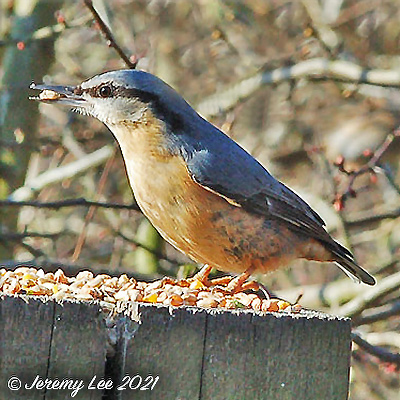
 |
|
Scientific Classifications explained » Amphibians » Ants » Aphids » Bees » Beetles » Birds » Bugs » Butterflies » Caterpillars » Damselflies » Dragonflies » Earwigs » Flies » Frog/Leafhoppers » Fungi » Galls » Grasshoppers » Harvestmen » Hoverflies » Lacewings » Ladybirds » Leaf Mines » Lichens » Mammals » Millipedes » Mosses » Moths » Sawflies » Slugs » Snails » Spiders » Trees & Shrubs » Wasps » Wild Flowers » Woodlice » Postboxes |
UK Nature > Birds > Sitta europaea

Scientific Name: Sitta europaea Common Name: Nuthatch Sitta europaea, more commonly known as the Nuthatch, has a long pointed bill and short tail and, unlike woodpeckers and the Treecreeper, it climbs up, down and around the tree trunk and branches using its powerful toes. The upperparts, wings, crown and nape are blue-grey and the underparts are orange-buff, changing red-brown on the flanks and towards the vent. Beneath the black eye stripe, which gives it a bandit-like appearance, is white. The bill is grey and the legs yellowish-brown. The Nuthatch feeds mainly on nuts and seeds, such as acorns and hazel nuts, in the autumn and winter, but insects, such as spiders and beetles in the summer. They are increasingly visiting gardens for nuts and seeds. It breeds in central and southern England and Wales, and is resident, with birds seldom travelling far from the woods where they hatch. |
|

https://www.uknature.co.uk is a website dedicated to showing the immense diversity of UK nature and wildlife. Our vast range of habitats, from lowland arable to snow covered mountains, from storm-ravaged coastlines to peaceful inland freshwater lakes and rivers, from dry, sandy heaths to deciduous and coniferous forests, all these habitats contribute to the abundance of UK nature. We have wild birds in huge numbers either residing or visiting our shores (597 recorded species as at July 2013) and we must also not forget the humble back garden with its grass lawns, flower beds filled with nectar rich flowers, shrubs and trees, all designed to attract huge numbers of insects such as bees, moths, butterflies and hoverflies; and finally the small ponds which provide safe havens for frogs, toads, newts and even slow worms and grass snakes. www.uknature.co.uk is the showcase for my personal passion, photographing uknature in all its glory. I sincerely hope you all enjoy the fruits of my labours. This site and all images contained therein is © Jeremy Lee 2004 - 2025. All Rights Reserved. Site design by Jeremy Lee. Site development & IT Support by Stuart Lee. |